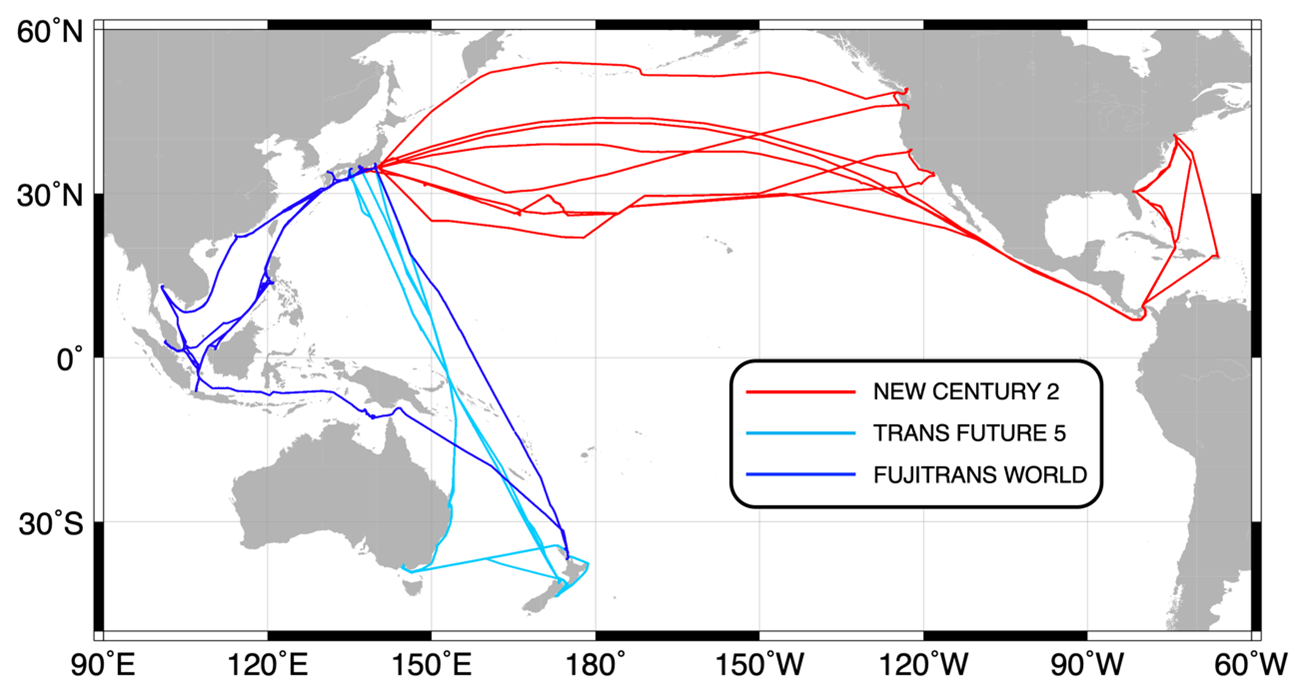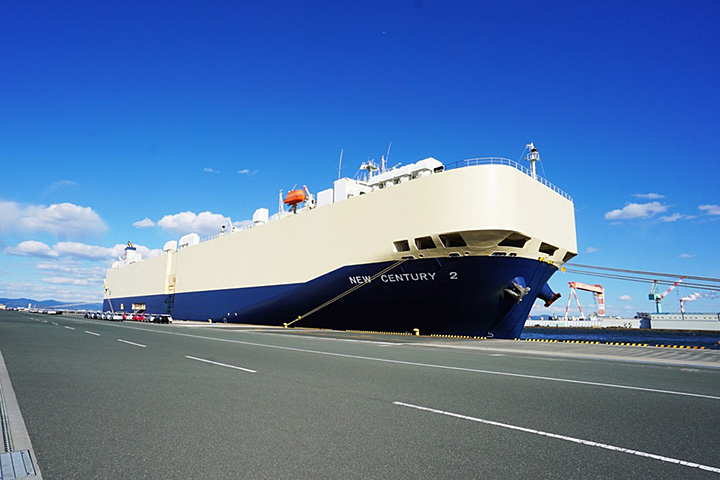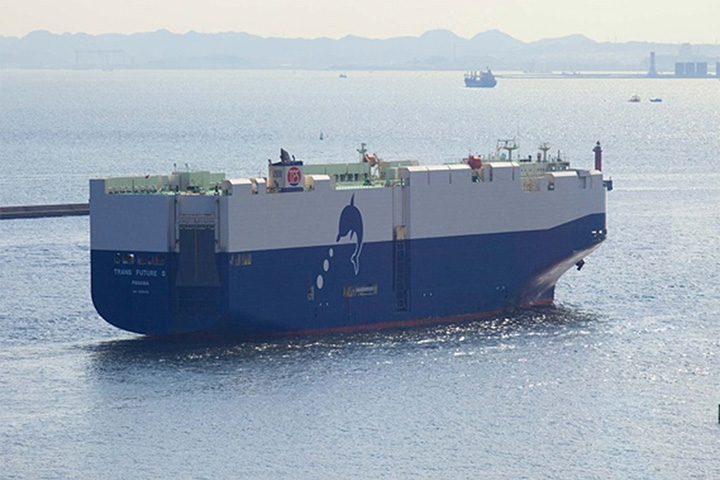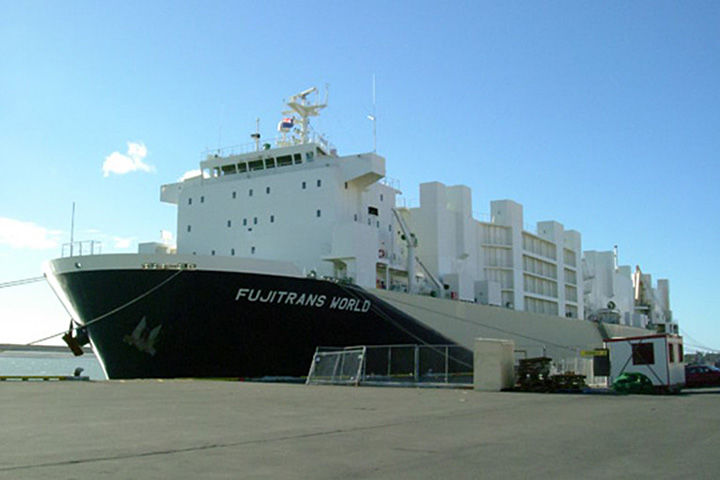Monitoring of GHGs over the Pacific Ocean using regular cargo ships

Objectives and Outline of the Project
Atmospheric observations of GHG concentrations have been conducted at more than 100 observation sites around the world. However, since there are many observation sites over land, atmosphere observations over the ocean, where the observation are scarce, have been required.
The ocean plays a role as a major carbon dioxide (CO2) sink. However, the spatial and temporal variability in the CO2 flux between the ocean and the atmosphere is very large. In order to precisely evaluate CO2 sinks and sources, direct observation of the CO2 concentration (partial pressure of CO2) in surface ocean is necessary, and ships can be considered as important "moving observation sites”.
In this monitoring project, commercial cargo ships, which regularly travel in a wide range of ocean areas at high frequencies, serve as "moving observation sites". Since 1995, we have been continuously monitoring GHGs in the atmosphere and surface ocean in the Japan-North America route.
Since 2001, TOYOFUJI SHIPPING CO., LTD., which is engaged in the export of automobiles, has been participating in this project and has taken over the observation of the Japan-North America route. Since 2005, the Japan-Oceania route (atmospheric and oceanographic observation), and also since 2007, the Japan-Southeast Asia route (atmospheric observation only) have been expanded and have continued to the present.
These observations of atmospheric GHG concentrations and the partial pressure of CO2 in surface seawater have not only revealed the spatio-temporal distribution of GHGs but have also contributed significantly to the evaluation of GHG sinks and emissions.
The following chart shows the routes of vessels currently in operation for the year 2020. Vessels in the Japan-North America and Japan-Oceania routes make approximately 8 round trips per year, and a vessel in the Japan-Southeast Asia route make approximately 12 round trips per year, contributing to the understanding of seasonal and annual variations of GHGs in the observation area.

Observation Methods
Each vessel is equipped with a space for atmospheric and oceanic observations and a variety of measuring instruments (see photo).
In atmospheric observations, an atmospheric CO2 measurement system and an automatic air sampling system has been installed to collect air samples above the ocean. In addition to CO2 concentration, carbon isotopes in CO2, the concentration of GHGs such as methane and dinitrogen monoxide are also measured, and recently continuous observation of methane concentration has also been carried out. Atmospheric oxygen-nitrogen ratio and concentrations of ozone and carbon monoxide are also measured simultaneously within this program.
In oceanic observations, the CO2 concentration in the equilibrium air produced by introducing seawater pumped from the ship’s bottom into a vapor-liquid equilibrator is measured in the same way as the atmospheric CO2 concentration.
At the same time, seawater temperature and salinity are continuously measured with high precision, and seawater is sampled three times a day to measure nutrients and other parameters.

For an overview of observations on each route, please click on the links below.
Publications
- Ono H., Toyama K., Enyo K., Iida Y., Sasano D., Nakaoka S., Ishii M. (2023) Meridional Variability in Multi-Decadal Trends of Dissolved Inorganic Carbon in Surface Seawater of the Western North Pacific Along the 165°E Line. Journal of Geophysical Research: Oceans, 128, e2022JC018842
- Friedlingstein P., O'Sullivan M., Jones W.M., Andrew M.R., Gregor L., Hauck J., Le Quere C., Luijkx I.T., Olsen A., Peters G.P., Peters W., Pongratz J., Schwingshackl C., Sitch S., Canadell J.G., Ciais P., Jackson B., Alin S.R., Alkama R., Arneth A., Arora V.K., Bates N.R., Becker M., Bellouin N., Bittig H.C., Bopp L., Chevallier F., Chini P., Cronin M., Evans W., Falk S., Feely R.A., Gasser T., Gehlen M., Gkritzalis T., Gloege L., Grassi G., Gruber N., Gurses O., Harris I., Hefner M., Houghton A., Hurtt G.C., Iida Y., Ilyina T., Jain A.K., Jersild A., Kadono K., Kato E., Kennedy D., Goldewijk K.K., Knauer J., Korsbakken J.I., Landschutzer P., Lefevre N., Lindsay K., Liu J., Liu Z., Marland G., Mayot N., McGrath M.J., Metzl N., Monacci N., Munro D.R., Nakaoka S., Niwa Y., O'Brien K., Ono T., Palmer P.I., Pan N., Pierrot D., Pocock K., Poulter B., Resplandy L., Robertson E., Rodenbeck C., Rodriguez C., Rosan T.M., Schwinger J., Seferian R., Shutler J.D., Skjelvan I., Steinhoff T., Sun Q., Sutton A.J., Sweeney C., Takao S., Tanhua T., Tans P.P., Tian X., Tian H., Tilbrook B., Tsujino H., Tubiello F., van der Werf G.R., Walker A.P., Wanninkhof R., Whitehead C., Wranne A., Wright R., Yuan W., Yue C., Yue X.Y., Zaehle S., Zeng J., Zheng B. (2022) Global Carbon Budget 2022. Earth System Science Data, 14 (11), 4811-4900
- Niwa Y., Sawa Y., Nara H., Machida T., Matsueda H., Umezawa T., Ito A., Nakaoka S., Tanimoto H., Tohjima Y. (2021) Estimation of fire-induced carbon emissions from Equatorial Asia in 2015 using in situ aircraft and ship observations. Atmospheric Chemistry and Physics, 21, 9455-9473
- Mueller A., Tanimoto H., Sugita T., Machida T., Nakaoka S., Patra P.K., Laughner J., Crisp D. (2021) New approach to evaluate satellite-derived XCO2 over oceans by integrating ship and aircraft observations. Atmospheric Chemistry and Physics, 21, 8255-8271
- Tokoro T., Nakaoka S., Takao S., Nojiri Y., Kuwae T., Kubo A., Endo T. (2021) Contribution of Biological Effects to Carbonate-System Variations and the Air -Water CO2 Flux in Urbanized Bays in Japan. Journal of Geophysical Research-Oceans, 126 (6)
- Hoshina Y., Tohjima Y., Katsumata K., Machida T., Nakaoka S. (2018) In situ observation of atmospheric oxygen and carbon dioxide in the North Pacific using a cargo ship. Atmospheric Chemistry and Physics, 18, 9283-9295
- Quere C.L., Andrew R.M., Canadell J.G., Sitch S., Korsbakken J.I., Peters G.P., Manning A.C., Boden T.A., Tans P.P., Houghton R.A., Keeling R.F., Alin S., Andrews O.D., Barbero L., Bopp L., Chevallier F., Chini L.P., Ciais P., Currie K., Delire C., Doney S.C., Friedlingstein P., Gkritzalis T., Harris I., Hauck J., Haverd V., Hoppema M., Goldewijk K.K., Jain A.K., Kato E., Kortzinger A., Landschutzer P., Lefevre N.L., Lenton A., Lienert S., Lombardozzi D.L., Melton J.R., Metzl N., Millero F., Monteiro P.M.S., Munro D.R., Nabel J.E.M.S., Nakaoka S., Brien K.O., Olsen A., Omar A.M., Ono T., Pierrot D., Poulter B., Rodenbeck C., Salisbury J., Schuster U., Schwinger (2016) Global Carbon Budget 2016. Earth System Science Data, 8, 1-45
- Dorothee C. E. Bakker, Benjamin Pfeil, Camilla S. Landa, Nicolas Metzl, Kevin M. O’Brien, Are Olsen, Karl Smith, Cathy Cosca, Harasawa S., Stephen D. Jones, Nakaoka S., Nojiri Y., Ute Schuster, Tobias Steinhoff, Colm Sweeney, Taro Takahashi, Bronte Tilbrook, Wada C., et al. (2016) A multi-decade record of high-quality fCO2 data in version 3 of the Surface Ocean CO2 Atlas (SOCAT). Earth System Science Data, 8, 383-413
- Yasunaka S., Ono T., Nojiri Y., Whitney F.A., Wada C., Murata A., Nakaoka S., Hosoda S. (2016) Long-term variability of surface nutrient concentrations in the North Pacific. Geophysical Research Letters, 43, 3389-3397
- Rodenbeck C., Bakker D. C. E., Gruber N., Iida Y., Jacobson A. R., Jones S., Landschutzer P., Metzl N., Nakaoka S., Olsen A., Park G.H. , Peylin P., Rodgers K.B., Sasse T.P., Schuster U., Shutler J.D., Valsala V., Wanninkhof R., Zeng J. (2015) Data-based estimates of the ocean carbon sink variability – first results of the Surface Ocean pCO2 Mapping intercomparison (SOCOM). Biogeosciences, 12, 7251-7278
- Zeng J., Nojiri Y., Nakaoka S., Nakajima H., Shirai T. (2015) Surface ocean CO2 in 1990-2011 modelled using a feed-forward neural network. Geoscience Data Journal, 2, 47-51.
- Nara H., Tanimoto H., Tohjima Y., Mukai H., Nojiri Y., and Machida T. (2014) Emissions of methane from offshore oil and gas platforms in Southeast Asia. Sci. Rep., 4(1), 6503, 10.1038/srep06503.
- Yasunaka S., Nojiri Y., Nakaoka S., Ono T., Whitney A. F., Telszewski M. (2014) Mapping of sea surface nutrients in the North Pacific: Basin-wide distribution and seasonal to interannual variability. Journal of Geophysical Research: Oceans, 119, 7756-7771
- Zeng J., Nojiri Y., Landschützer P., Telszewski M., Nakaoka S. (2014) A Global Surface Ocean fCO2 Climatology Based on a Feed-Forward Neural Network. J. Atmos. Ocean. Tech., 31 (8), 1838-1849
- Yasunaka S., Nojiri Y., Nakaoka S., Ono T., Mukai H., Usui N. (2014) North Pacific dissolved inorganic carbon variations related to the Pacific Decadal Oscillation. Geophys. Res. Lett., 41, 1005-1011
- Nakaoka S., Telszewski M, Nojiri Y., Yasunaka S., Miyazaki C., Mukai H., Usui N. (2013) Estimating temporal and spatial variation of ocean surface pCO2 in the North Pacific using a self-organizing map neural network technique. Biogeosciences, 10, 6093-6106
- Yasunaka S., Nojiri Y., Nakaoka S., Ono T., Mukai H., Usui N. (2013) Monthly maps of Sea Surface Dissolved Inorganic Carbon in the North Pacific: Basin-wide Distribution and Seasonal Variation. J. Geophys. Res., 118 (8), 3737-3977
- Yokouchi Y., Nojiri Y., Toom-Sauntry D., Fraser P., Inuzuka Y., Tanimoto H., Nara H., Murakami R., and Mukai H. (2012) Long-term variation of atmospheric methyl iodide and its link to global environmental change, Geophys. Res. Lett., 39, L23805, 10.1029/2012GL053695.
- T. Aramaki, Y. Nojiri, H. Mukai, S. Kushibashi, M. Uchida, and Y. Shibata Y. (2010) Preliminary results of radiocarbon monitoring in the surface waters of the North Pacific, Nucl. Instrum. Methods Phys. Res. B, 268, 1222-1225, 10.1016/j.nimb.2009.10.138.
- T. Takahashi, S. C. Sutherland, R. Wanninkhof, C. Sweeney, R. A. Feely, D. W. Chipman, B. Hales, G. Friederich, F. Chaves, C. Sabine, A. Watson, D. C. E. Bakker, U. Schuster, N. Metzl, H. Yoshikawa-Inoue, M. Ishii, T. Midorikawa, Y. Nojiri, A. Kortzinger, T. Steinhoff, M. Hoppema, J. Olafsson, T. S. Arnarson, B. Tilbrook, T. Johannessen, A. Olsen, R. Bellerby, C. S. Wong, B. Delille, N. R. Bates, and H. J. W. de Baar. (2009) Climatologocal mean and decadal change in surface ocean pCO2 and net sea-air CO2 flux over the global oceans, Deep-Sea Res. II, 56, 554-577, 10.1016/j.dsr2.2008.12.009.
- Y. Yokouchi, K. Osada, M. Wada, F. Hasebe, M. Agama, R. Murakami, H. Mukai, Y. Nojiri, Y. Inuzuka, D. Toom-Sauntry, and P. Fraser. (2008) Global distribution and seasonal concentration change of methyl iodide in the atmosphere, J. Geophys. Res. Atmospheres, 113, D18, D18311, 10.1029/2008JD009861.
- C. S. Wong, D. A. Timothy, C. S. Law, Y. Nojiri, L. X. S.-K. E. Wong, and J. S. Page. (2006) Carbon distribution and fluxes during the SERIES iron fertilization experiment with special reference to the fugacity of carbon dioxide (fCO2), Deep-Sea Research II, 53, 2053–2074, 10.1016/j.dsr2.2006.05.036.
- A. Fransson, M. Chierici, and Y. Nojiri. (2006) Increased net CO2 outgassing in the upwelling region of the southern Bering Sea in aperiod of variable marine climate between 1995 and 2001, J. Geophys. Res. Oceans, 111, C8, C08008, 10.1029/2004JC002759.
- V. V. S. S. Sarma, T. Saino, K. Sasaoka, Y. Nojiri, T. Ono, M. Ishii, H. Y. Inoue, and K. Matsumoto. (2006) Basin-scale pCO2 distribution using satellite sea surface temperature, Chl a, and climatological salinity in the North Pacific in spring and summer. Global Biogeochem. Cycles, 20, GB3005, 10.1029/2005GB002594.
- M. Chierici, A. Fransson, and Y. Nojiri. (2006) Biogeochemical processes as drivers of surface fCO2 in contrasting provinces in the subarctic North Pacific Ocean, Global Biogeochem. Cycles, 20, GB1009, 10.1029/2004GB002356.
- Y. Yokouchi, F. Hasebe, M. Fujiwara, H. Takashima, M. Shiotani, N. Nishi, Y. Kanaya, S. Hashimoto, P. Fraser, D. Toom-Sauntry, H. Mukai, and Y. Nojiri. (2005) Correlations and emission ratios among bromoform, dibromochloromethane, and dibromomethane in the atmosphere, J. Geophys. Res. Atmospheres, 110, D23, D23309, 10.1029/2005JD006303.
- Y. Tohjima, H. Mukai, T. Machida, Y. Nojiri, and M. Gloor. (2005) First measurements of the latitudinal atmospheric O2 and CO2 distributions across the western Pacific, Geophys. Res. Lett., 32, L17805, 10.1029/2005GL023311.
- K. Watanabe, Y. Nojiri, and S. Kariya. (2005) Measurements of ozone concentrations on a commercial vessel in the marine boundary layer over the northern North Pacific Ocean, J. Geophys. Res. Atmospheres, 110, D11, D11310, 10.1029/2004JD005514.
- H. Kitagawa, H. Mukai H, Y. Nojiri, Y. Shibata, T. Kobayashi T and T. Nojiri. (2004) Seasonal and secular variations of atmospheric CO2-C-14 over the western Pacific since 1994, Radiocarbon, 46, 901-910.
- C. S. Wong, N. A. D. Waser, Y. Nojiri, W. K. Johnson, F. A. Whitney, J. S. Page and J. Zeng. (2002) Seasonal cycles of nutrients and dissolved inorganic carbon at high and mid latitudes in the North Pacific Ocean: determination of new production and nutrient uptake ratios, J. Oceanogr., 58, 227-243.
- T. Takahashi, S. C. Sutherland, C. Sweeney, A. Poisson, N. Metzl, B. Tilbrook, N. Bates, R. Wanninkhof, R. A. Feely, C. Sabine, J. Olafsson, and Y. Nojiri. (2002) Global sea-air CO2 flux based on climatological surface ocean pCO2, and seasonal biological and temperature effects, Deep-Sea Res. II, 49, 1601-1622.
- J. Zeng, Y. Nojiri, P. P. Murphy, C. S. Wong, and Y. Fujinuma. (2002) A comparison of ΔpCO2 distributions in the northern North Pacific using results from a commercial vessel in 1995-1999, Deep Sea Res. II, 5303-5315.
- C. S. Wong, N. A. D. Waser, Y. Nojiri, F. A. Whitney, J. S. Page, and J. Zeng. (2002) Seasonal cycles of nutrients and dissolved inorganic carbon at high and mid latitudes in the North Pacific Ocean during the Skaugran cruises: determination of new production and nutrient uptake ratios, Deep Sea Res. II, 49, 5317-5338.
- M. Mochida, Y. Kitamori, K. Kawamura, Y. Nojiri, and Suzuki K. (2002) Fatty acids in the marine atmosphere: Factors governing their concentrations and evaluation of organic films on sea-salt particles, J. Geophys. Res. Atmospheres, 107, D17, D4325, 10.1029/2001JD001278.
- Y. Obayashi, E. Tanoue, K. Suzuki, N. Handa, Y. Nojiri and C. S. Wong. (2001) Spatial and temporal variabilities of phytoplankton community structure in the northern North Pacific as determined by phytoplankton pigments, Deep-Sea Res. I, 48, 439-469.
- P. P. Murphy, Y. Nojiri, D. E. Harrison and N. K. Larkin. (2001) Scales of spatial variability for surface ocean pCO2 in the Gulf of Alaska and Bering Sea: toward a sampling strategy, Geophys. Res. Lett., 28, 1047-1050.
- P. P. Murphy, Y. Nojiri, Y. Fujinuma, C. S. Wong, J. Zeng, T. Kimoto and H. Kimoto. (2001) Measurements of surface seawater fCO2 from volunteer commercial ships: Techniques and experiences from Skaugran, J. Atmos. Ocean. Technol., 18, 1719-1734.
- Y. Yokouchi, Y. Nojiri, L. A. Barrie, D. Toom-Sauntry and Y. Fujinuma. (2001) Atmospheric methyl iodide: High correlation with surface seawater temperature and its implications on the sea-to-air flux, J. Geophys. Res., 106, 12661-12668.
- Y.Yokouchi, Y.Nojiri, L.A.Barrie, D.Toom-Sauntry, T.Machida, Y.Inuzuka, H.Akimoto, H.-J.Li, Y.Fujinuma and S.Aoki. (2000) A strong source of methyl chloride to the atmosphere from tropical coastal land, Nature, 403, 295-298.
- Y.Yokouchi, T.Machida, L.A.Barrie, D.Toom-Sauntry, Y.Nojiri, Y.Fujinuma, Y.Inuzuka, H.-J.Li, H.Akimoto and S.Aoki. (2000) Latitudinal distribution of atmospheric methyl bromide measurements and modeling, Geophys. Res. Lett., 27, 697-700.
- M.Uematsu, K.Kinoshita, and Y.Nojiri. (2000) Scavenging of insoluble particles from the marine atmosphere over the sub-arctic North Pacific, J. Atmos. Chem., 35, 151-164.
Cooperative organizations for this monitoring project
- National Oceanic and Atmospheric Administration (NOAA, U.S.A.)-Pacific Marine Environmental Laboratory (NOAA/PMEL) and Atlantic Oceanographic and Meteorological Laboratory (NOAA/AOML)
- Commonwealth Scientific and Industrial Research Organization(Australia)
- Institute of Ocean Sciences (Canada)
- National Institute of Water and Atmospheric Research (New Zealand)
Acknowledgement
This monitoring project has been made possible by the cooperation of many people, including shipowners, operators, captains and crew members of cooperating vessels, and port agencies. We are grateful to everyone involved.




